Alter our very relaxing time in Placencia, we caught a bus down south on the long, straight southern highway that passes through mile upon mile of scrubby lowland forest, as far as the eye can see. It looked like the forestry service was trying, and failing, to plant caribbean pine. The soil was probably degraded, as only a few very spindley trees had made it above the scrub layer – hopefully they´ll let the land lie and let it recover naturally before trying anything else.
We ended up in Punta Gorda (´PG´ to locals), a (very) sleepy port town with boats over to Guatamala. From here we were to catch a bus up to San Pedro Columbia, a Kek´chi mayan village in the foothills of the Maya Mountains. Once there we needed to get someone to guide us up the river to the Mayan Mountain Research Farm (MMRF), where we were going to volunteer for three weeks. As it happened, we missed the only bus going there by 15 minutes, as we´d been told the wrong time. However, because ´PG´ is such a friendly place, we soon got talking to a guy on his bike and asked him if he knew someone who could give us a lift. Turned out his cousin could, for a price (which was still cheaper than getting a local taxi).
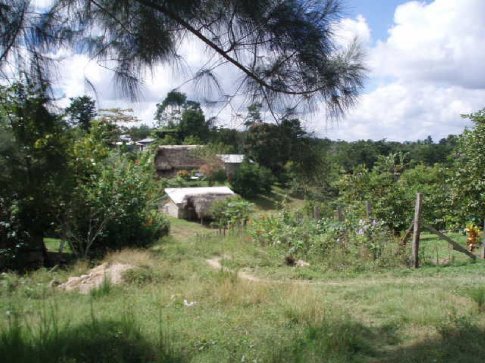
A sleepy scene in San Pedro Columbia, maybe ´cos of all the ganja...
After a bumpy ride, we arrived in San Pedro Columbia, a mayan village with spread out, well maintained houses with plank walls and palm-thatch roofs, surrounded by lovingly tended gardens. Apparently the village is renowned as one of the main centres in Belize for ganja growing, which takes place up in the bush! The guys found us a guide to the farm – a Kek´chi guy called Artemis who used to work at MMRF. He hoisted our heaviest backpack and then took us up the jungle path. After half an hour we headed down a steep slope to the river, where he proceeded to wade across and fetch a small ´dory´ for us – these are dug-out canoes that the locals use to traverse the river. Chris, the owner, later turned up with Kira, the new farm manager, and his two daughters. We settled in to our rather nice accomodation, or ´posh house´ - a timber-built, three storey open-air structure with a mezzanine bed platform and a nice view over the valley.
Chris has been busy over the years building plenty of structures on the farm, including a classroom, a number of volunteer accomodations, barns, and of course his own lovely house with outside kitchen and dining area (built out fallen hardwood timber from the 2001 hurricane). All power is from roof-borne solar panels and a micro wind turbine, and water is piped from a nearby spring. As at our previous two destinations, toilets are of the compost variety, and very posh they are too.
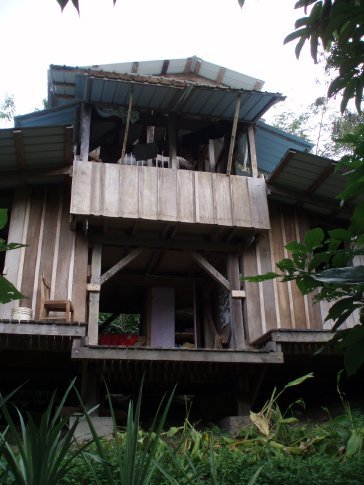
Our Posh Accomodation
The farm is mostly agroforestry, with some staple crops and garden, on a slope overlooking a river. It´s surrounded by secondary forest (the primary stuff was all flattened, along with everyone´s houses in the 2001 hurricane) and the forest around the cultivated part of the farm was destroyed by a fire which spread from a neighbouring property last year.
As at the project on Ometepe, the farm works by providing food whilst protecting and maintaining the fertility of the vulnerable tropical soil, and a wealth of habitats approaching that of the unmanaged forest. Fruit and nut trees (eg: avocadoes, coconuts, breadnuts, golden plum) provide the top canopy layer, along with nitrogen-fixing trees. Below these are smaller trees like Cacoa, papaya and pigeon pea - and these all provide shade for other crops including pineapples, cassava, coco yam, coffee, sweet pototoes, turmeric, ginger and vanilla. On the recently burnt slopes Chris has planted fields of black corn and black beans, and down on the river flood-plain is a vegetable garden to provide some much needed greens – this floods in the wet season which enriches the soil. Meanwhile chickens and ducks provide fresh eggs.
One of the first things we noticed at the farm was the wealth of small birds flitting around – most of which we hadn´t seen before. Because much of the surrounding forest had recently been burnt, there weren´t that many mammals around – except for the ever-present agoutis (´rabbits´or gibnut in Belize – they eat them!), bats (unfortunate victims of the farm´s cats) and the odd marguay (Chris was keeping his chickens in at night after a few had been munched). In previous years Jaguars have come through the area – Chris had lost a handful of dogs to them over the years, a common story throughout the forested areas of Belize.
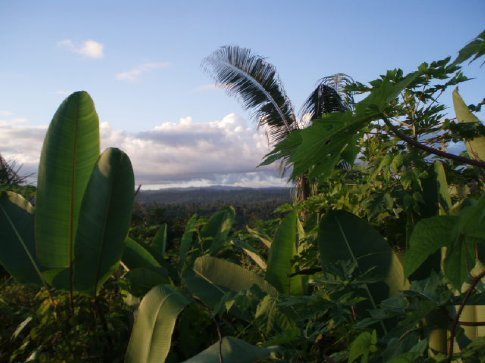
Views across uninterupted forest, above MMRF
The three main tasks on the farm that we were involved with were planting, collecting and processing crops, and cooking. We helped the farm´s workers plant beans using a planting stick and four beans per hole – a very meditative task, and very fulfulling, as after a week the beans were already six inches high! (things grow damn fast here). We also helped plant pineapple tops across the contour (to prevent erosion), and cassava (a simple matter of burying longitudinal cuttings after harvesting the tubers of a plant). We also planted numerous tree seedlings to replace those lost to the fire and harvested and planted more coffee. This involved hauling all the pot-soil up from a hole next to the river. A rather labourious process, which I´m sure built up my shoulder muscles no end...
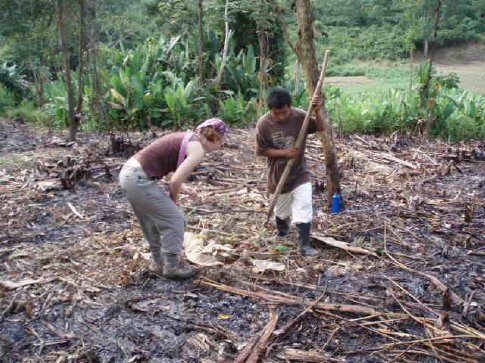
Rachel plants black beans with James
We collected food from the farm like chaya (a tree whose leaves approximate to spinach – once you´ve boiled the poisons out of them), cassava (or ´yucca´ in spanish), breadnut, cacoa, cho-cho (a vine fruit something like marrow), papaya and squash. One thing that our time at the farm brought home to us was the amount of processing a lot of these foods require. Beans need to be dried, and then podded, and then boiled. Corn needs to be de-husked, then ´shucked´ off the cob, then either smashed and boiled into a gruel, or hand-ground to make corn flour. Breadnuts need to be taken out of their pulp and then boiled for hours, cocoa beans need to be de-pulped, fermented and then roasted – the list goes on! Many a morning was spent hunched over buckets, dipping our hands into fermenting breadnut fruit mush! (yum).
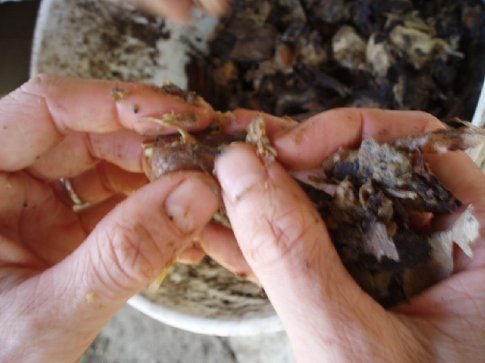
Getting stuck in to the breadnut mush in the bucket. Not for the squeamish.
On the cooking side, our stay also provided a good lesson in cooking seasonally available crops. Most of our food was grown on the farm, as getting food from outside requires a trip two miles downriver on a dory to San Pedro, and then maybe a drive down to Punta Gorda as well. We cooked on a wood-fueled metal ´box´ - a simple fire box with hobs above, a chimney, and an oven space. Beans n´rice was the order of the day, supplemented by whatever else was ready on the farm. Needless to say, the limited ingredients got us making some very imaginative creations! Rachel helped Kira to prepare ´tamales´ which are dumpling-like balls of ´masa´ (corn flour bleached in alkali), cooked in turmeric leaves.

Making Tamales
Entertainment was provided by the girls (want to jump on the trampoline?!) and by the farm´s various adopted animals including Peg (´two cho-cho´ - after the time he managed to get two cho-cho in his little mouth at the same time), a ginger kitten who insisted on stealing our food, and getting a bath in return every mealtime, Balea, a very mangy dog (go away!), Nancy a very pregnant bitch (I need to find a den!), and Jimmy (poopers), a Chihuahua with a propensity for begging. Oh, and Daniel trying to brain himself repeatedly on trapdoors and roof eaves. Ow.
The other notable wildlife was the bugs. My, my, were there bugs. Basically, all the types we´ve complained about before (mosquitoes, sand flies, horse flies, other unnameables), but more of ´em – even than on Ometepe . This wasn´t helped by the fact that the rainy season was having a last good ol´ go and drowning us. Needless to say, we spent most of the time in as many clothes as we could bear, using liberal amounts of repellant, intermittently flattening offenders. The rainy weather also made for some very cold nights - probably still 10 degrees, but in outdoor structures this bites! We ended up with six blankets on our bed one night.
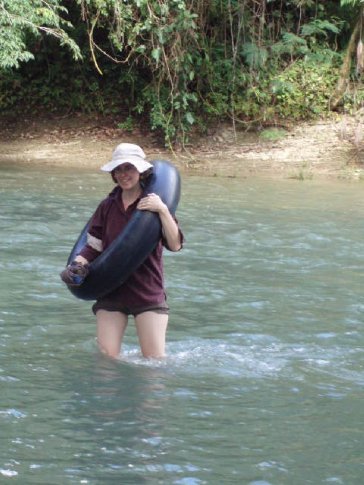
Rachel, intrepid explorer
Besides work on the farm we also got to go on adventures! One day I went down river on a dory with Nicasio, one of the farm workers, to pick up a load of solar gear for an installation Chris was doing at a local school. After balancing everything in the wobbly boat, Nicasio then had to pole it upstream, past rapids, with me getting out periodically and wading so that the dory didn´t ground in the shallows. We also inner-tubed down from the ´source´ - where the river emerges from under a dry valley (this whole area is limestone karst, so like the peak district and bits of Slovenia, there are rivers and caves everywhere).
In fact, floating down the river was the best way of getting to San Pedro, as the path was usually a swampy, muddy quagmire. On Christmas day Rachel, Kira and I donned our water gear, dry bag and inner tubes and floated, through the pouring rain, down to the village, got changed into some dry stuff under the school veranda, and then marched up to the only house in the village with a phone, so that we could phone our parents. After a few stouts at ´Mag´s Cool Spot´ - the local bar, we then drudged through the rain up the hazardous jungle path, and swam back across the river to the farm – a very different Christmas from what we´re used to!
Click here for Rachel´s Christmas Day Video...
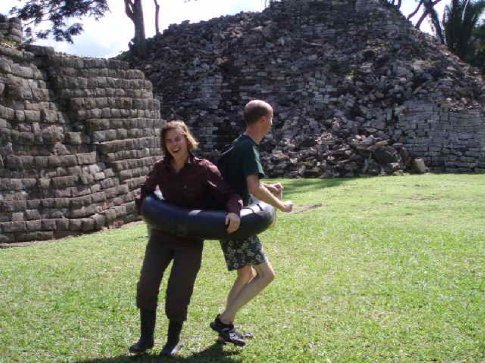
Marital bliss at Lubuntuun Ruins... and Rachel covered up to escape the bugs!
Our other adventure was on New Years Day, when we floated/waded/swam down the river to visit the Mayan city of Lubuntuun. After we´d found a promising-looking path into the bush, we walked along heliconia-shaded streams that flowed shallowly over limestone pavements, dropping every now and then into beautiful crystal clear pools. Lubuntuun ruins have a more cozy air than those at Copan – the plazas and temples are smaller and at a more human scale. The stones aren´t mortared, but masoned so well that they fit together like a jigsaw puzzle, a bit like at some Inca sites. This is the site where a British ´gentleman archaeologist´ (read treasure looter) found a large crystal skull in the 1920´s, supposedly with magical powers (serious bad juju). It doesn´t need saying that Mag´s cool spot also got another visit – its amazing how much you miss a cold beer in the bush!
One of my abiding memories of the farm is crouching, chest deep in the river, a backpack on my back, watching the serene water flowing by and looking up at the birds and the trees, while minnows nibbled at my fingers....
We enjoyed our time at the farm, but after three weeks of rain and innumerable bites, we were ready for a well-earned break!
To see lots more pictures of our time at MMRF, click here:
http://journals.worldnomads.com/rachel_and_daniel/gallery/15595.aspx
For Rachel's Chrimbo YouTube Message, Click here!
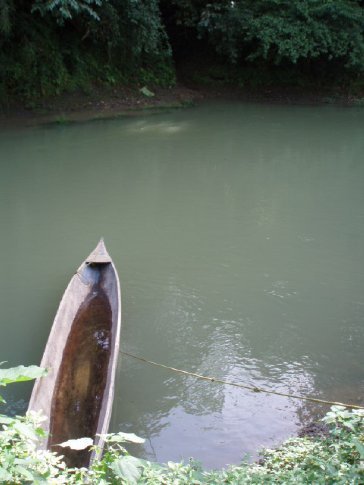
The Dory across the river